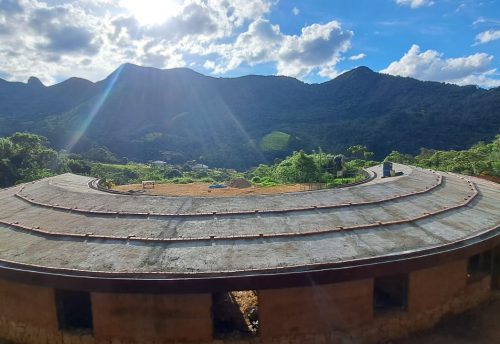
There are many techniques and materials for how you can build a wall. Most people are familiar with the current conventional methods; bricks, concrete blocks, and drywall immediately come to mind. How you build a wall made of cob, however, is a totally different process. Be sure to familiarize yourself with what cob is and how to make it before you start building your wall(s)!
To build a cob wall, you must first make a base structure. This is essential for supporting the weight of the walls and for keeping them at an appropriate distance from the ground’s humidity. That means your base needs to be at least 20 cm tall. To be clear, that’s the absolute minimum – the higher the humidity is, the higher the base will need to be, too. Here, we will be using stone for our base construction since it is one of the most common, resilient, and accessible options available.
Generally speaking, stone bases can be built in one of two ways. One such way is the drystack method which requires quality stones in a wide variety of sizes and, more importantly, demands expertise. This technique involves stacking stones without using any mortar to hold the rocks together. In theory, this is as simple as it gets… just a long pile of rocks and nothing else. But in practice, this technique demands a great deal of effort, planning, patience, and skill. We have used this natural building (bioconstruction) technique at our Eco Lodge project, as you can see in the photo below. Though not as environmentally-friendly, the second – quicker and easier – approach is to build your stone base using mortar to fill in the cracks and bind the stones together.
With the base of the wall complete, we can begin “raising the cob.” We lift a handful of cob over the walls and shape it. One hand can be the shape while the other compresses the cob and incorporates it into the bottom layer. It is important to make a large monolith with the cob, avoiding weak connections between the layers. These connections can be made with the thumbs or with the help of a stick.
The top of the wall must be moist so that the next layer can adhere, and the bottom dry enough to support the weight of more cob. Drilling holes in the top of the walls – when you plan to finish the same wall the next day – helps in fitting the new cob. We also use a mixture of sieved clay and water to moisten the walls when they are dry and to help the new layer stick.
It is also important to take care of both sides of the wall, internal and external, so that it grows steadily. Remember: it is always better to make the walls too thick than too thin. The walls can be checked with a leveler and, at the end, trimmed to be more accurate. A machete, a cleaver, a saw, or a shovel can make good tools for this.
After the foundation is made and the walls are erected, trimmed, and dried , it will be practically ready. Building cob walls is as simple and fun as that!
[vc_btn title=”Learn More About Volunteering With Us!” style=”outline-custom” outline_custom_color=”#666666″ outline_custom_hover_background=”#33b208″ outline_custom_hover_text=”#ffffff” shape=”round” size=”lg” align=”center” button_block=”true” link=”url:https%3A%2F%2Fecocaminhos.com%2Fvolunteer-opportunities%2F|title:%5B%3Aen%5DVOLUNTEER%20APPLICATION%20FORM%5B%3Abr%5DFormul%C3%A1rio%20de%20aplica%C3%A7%C3%A3o%5B%3Asp%5DFormulario%20de%20aplicaci%C3%B3n%5B%3Aes%5DFormulario%20de%20aplicaci%C3%B3n%5B%3Apb%5DFormul%C3%A1rio%20de%20aplica%C3%A7%C3%A3o%5B%3A%5D|target:%20_blank|”]![[:en]Eco Caminhos: Permaculture & Agroforestry Farm in Brazil[:br]Eco Caminhos: Fazenda de Permacultura e Agrofloresta no Brasil[:sp]Permacultura y Agroforestería en Brasil: Eco Caminhos[:]](https://ecocaminhos.com/wp-content/uploads/2024/02/Eco-Caminhos-logo-without-border.png)

 Português
Português Español
Español



